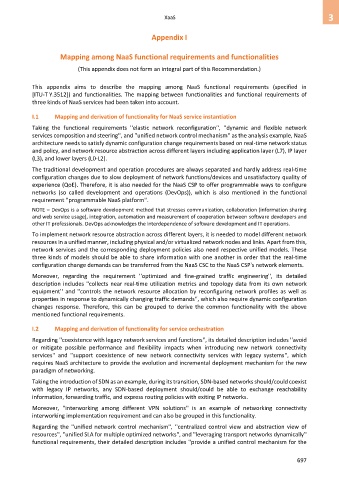Page 705 - Cloud computing: From paradigm to operation
P. 705
XaaS 3
Appendix I
Mapping among NaaS functional requirements and functionalities
(This appendix does not form an integral part of this Recommendation.)
This appendix aims to describe the mapping among NaaS functional requirements (specified in
[ITU-T Y.3512]) and functionalities. The mapping between functionalities and functional requirements of
three kinds of NaaS services had been taken into account.
I.1 Mapping and derivation of functionality for NaaS service instantiation
Taking the functional requirements ''elastic network reconfiguration'', ''dynamic and flexible network
services composition and steering'', and ''unified network control mechanism'' as the analysis example, NaaS
architecture needs to satisfy dynamic configuration change requirements based on real-time network status
and policy, and network resource abstraction across different layers including application layer (L7), IP layer
(L3), and lower layers (L0-L2).
The traditional development and operation procedures are always separated and hardly address real-time
configuration changes due to slow deployment of network functions/devices and unsatisfactory quality of
experience (QoE). Therefore, it is also needed for the NaaS CSP to offer programmable ways to configure
networks (so called development and operations (DevOps)), which is also mentioned in the functional
requirement ''programmable NaaS platform''.
NOTE – DevOps is a software development method that stresses communication, collaboration (information sharing
and web service usage), integration, automation and measurement of cooperation between software developers and
other IT professionals. DevOps acknowledges the interdependence of software development and IT operations.
To implement network resource abstraction across different layers, it is needed to model different network
resources in a unified manner, including physical and/or virtualized network nodes and links. Apart from this,
network services and the corresponding deployment policies also need respective unified models. These
three kinds of models should be able to share information with one another in order that the real-time
configuration change demands can be transferred from the NaaS CSC to the NaaS CSP's network elements.
Moreover, regarding the requirement ''optimized and fine-grained traffic engineering'', its detailed
description includes ''collects near real-time utilization metrics and topology data from its own network
equipment'' and ''controls the network resource allocation by reconfiguring network profiles as well as
properties in response to dynamically changing traffic demands'', which also require dynamic configuration
changes response. Therefore, this can be grouped to derive the common functionality with the above
mentioned functional requirements.
I.2 Mapping and derivation of functionality for service orchestration
Regarding ''coexistence with legacy network services and functions'', its detailed description includes ''avoid
or mitigate possible performance and flexibility impacts when introducing new network connectivity
services'' and ''support coexistence of new network connectivity services with legacy systems'', which
requires NaaS architecture to provide the evolution and incremental deployment mechanism for the new
paradigm of networking.
Taking the introduction of SDN as an example, during its transition, SDN-based networks should/could coexist
with legacy IP networks, any SDN-based deployment should/could be able to exchange reachability
information, forwarding traffic, and express routing policies with exiting IP networks.
Moreover, ''interworking among different VPN solutions'' is an example of networking connectivity
interworking implementation requirement and can also be grouped in this functionality.
Regarding the ''unified network control mechanism'', ''centralized control view and abstraction view of
resources'', ''unified SLA for multiple optimized networks'', and ''leveraging transport networks dynamically''
functional requirements, their detailed description includes ''provide a unified control mechanism for the
697

